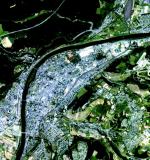|
|
|
 |
 |
 |
 |
REMOTE SENSING |
 |
|
|
The Remote Sensing Department of the University of Trier has started its activities in 1974 and is part of the Faculty of Geography/Geosciences in which major emphasis is given to the interdisciplinary co-operation between the various geoscientific disciplines (i.e. Geology, Pedology, Hydrology, Geobotany, Climatology and Physical Geography). Besides teaching within the fields of Applied Physical Geography and Applied Environmental Sciences, the department has acquired expertise in various aspects of remote sensing and GIS applications with a focus on optical sensors.
|
|
|
|
|
The Remote Sensing Department is one of the faculty centres for geo-information processing (GeoMatics). Its research and educational tasks are mainly oriented towards interdisciplinary environmental monitoring issues with operational and experimental sensors (multi- and hyperspectral imaging systems), the integration of remote-sensing-derived information layers into Geographic Information Systems, and the development of specific image processing tools.
The core of research comprises environmental monitoring and modelling using earth observation and airborne remote sensing data. The departments activities therefore comprise the development of new and standardised image processing techniques, sensor calibration, spectrometry, reflectance modelling, integration of remote sensing data and GIS, and methods of visual interpretation of maps and remote sensing images.
Important research topics concentrate on the extraction of soil and vegetation characteristics from remotely sensed imagery for applications in agriculture and forestry, assessments of ecological risks (land degradation and desertification studies), and the use of RS data for the sustainable management of natural resources.
Local research focuses on Mediterranean ecosystems and the continental biogeographic zone. Specific agriculture and forestry studies in a more limited regional context are also done within the federal state of Rhineland-Palatinate. Methodological developments relate to field- and laboratory spectrometry, empirical and analytical mo-delling approaches, as well as to advanced pattern recognition.
Since 1994, the Remote Sensing Department has been involved in numerous European, German and regionally focused research projects. Beyond research on desertification, numerous projects focused on topics such as forest damage assessment, fire ecology, and hydrological modelling, among others.
The departments remote sensing/GIS laboratory is well equipped with 8 SUN workstations, a NT-server with client PCs. Primary software packages in use are ERDAS Imagine, ENVI/IDL, ARC/Info, and ArcView along with several other in-house developed programmes centred around GIS, image analysis and computer graphics.
Therefore, the departments role in the scenario of environmental and geosciences lies in the integration of several traditional scientific fields with new developments, like digital image processing techniques, raster-vector-integration or web-mapping approaches. In general, the focus of interest could be entitled “Applied Geoinformatics”.
This also best describes the potential field of work for most of our students, either in research or in companies employing staff with a strong background in digital remote sensing techniques and GIS.
Remote Sensing can be chosen as major or minor subject within all of our curricula (Applied Geography, Applied Physical Geography, Applied Environmental Sciences).
The following courses are offered regularly during the winter and/or summer terms:
Basic Level
· Principles of Remote Sensing, Lecture, 2 hours
· Introduction into Techniques of Remote Sensing, Exercise, 3 h
· Remote Sensing/GIS I: Integration of Spatial Data, Exercise, 3 h
Advanced Level
· Introduction into Digital Image Processing, Lecture, 2 hours
· Digital Image Processing I, Exercise, 3 hours
· Remote Sensing/GIS II: Integration of Spatial Data, Exercise, 3 hours
· Remote Sensing in Agriculture and Forestry, Exercise, 2 hours
These courses will be complemented by lectures, seminars and exercises on more specific topics. For the participants from Socrates partner universities, most courses can be held in English language.
Any further questions about the Department of Remote Sensing? Please contact:
Head of Department
Prof. Dr. Joachim Hill
E-Mail:  hillj@uni-trier.de hillj@uni-trier.de
+49 (0)651 201-4592
Scientific Staff
Dr. Clement Atzberger
Dr. rer. nat. Patrick Hostert
Dr. rer. nat. Thomas Udelhoven
Project Staff
Dipl.-Geogr. Thomas Jarmer
Dipl.-Geogr. Achim Röder
Dipl.-Geogr. Martin Schlerf
Dipl.-Geogr. Stephan Seeling
Dipl.-Geogr. Ellen Sell
Secretary
Hermine Marx
E-Mail:  marxine@uni-trier.de marxine@uni-trier.de
+49 (0)651 201-4591
 Homepage Remote Sensing Homepage Remote Sensing
|
|


